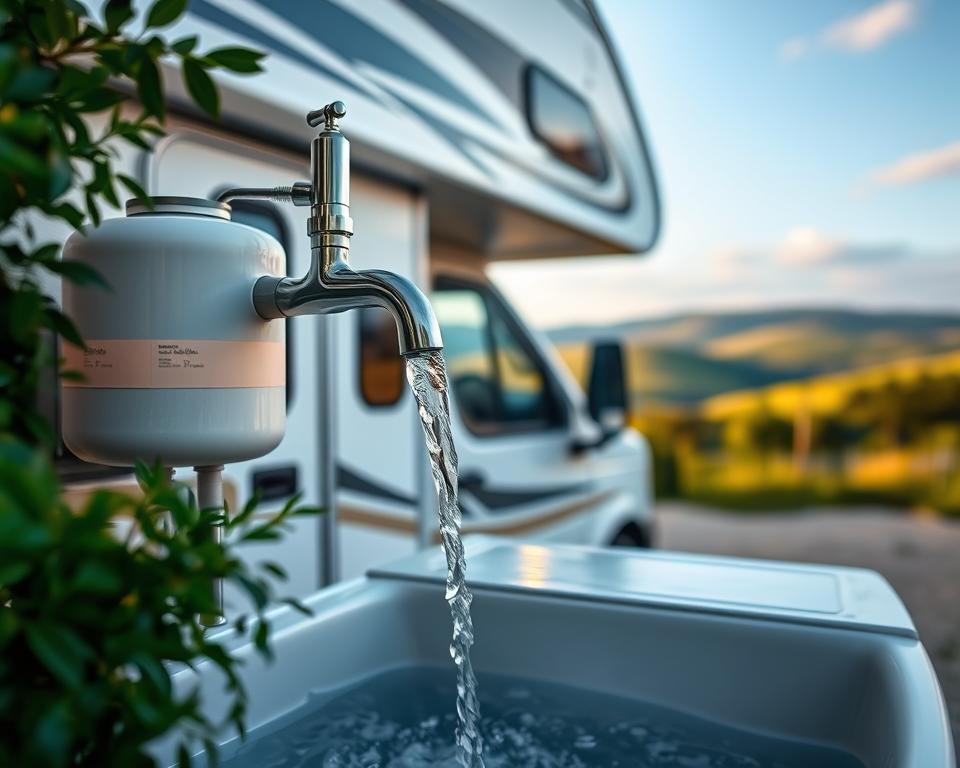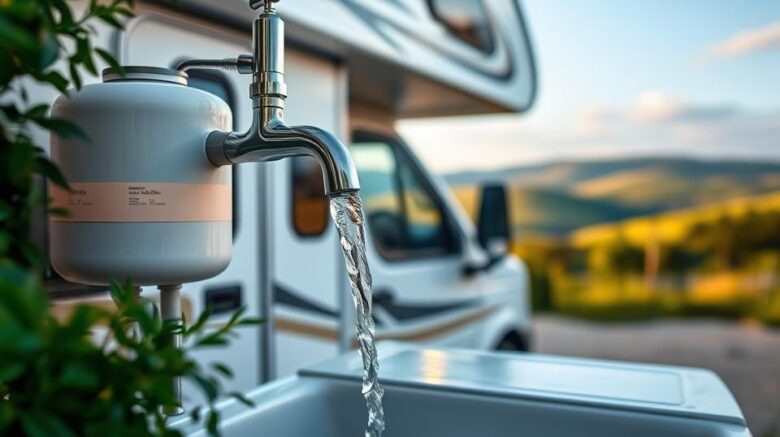Optimize Your RV Water System with a Pressure Tank
Have you ever wondered the impact of an RV pressure tank on your camping ventures? When you’re roaming, your RV’s plumbing system becomes vital for daily activities like bathing and dishwashing. Fine-tuning this system ensures a consistent and dependable water flow, essential while traveling. Let’s delve into how an RV pressure tank can boost your onboard water system – RV black water macerator pump, uplifting comfort during your adventures.
Critical Findings
- A camper pressure tank boosts flow on the move.
- Dependable pressure matters for routine use.
- Optimizing your RV water system increases comfort while camping.
- Pressure vessels ensure even delivery.
- Better flow aids all plumbing operations.
The Value of Consistent Water Pressure in Your RV
Dependable water flow makes camping hassle-free. It ensures daily tasks like showering, washing dishes, and using the toilet are smooth. Challenges such as low water pressure can disrupt these activities, highlighting the necessity of proper water flow in your RV.
Low water pressure can stem from multiple problems. Leaks, clogged filters, or insufficient water supply are common causes. Not only do these problems interfere with convenience, but they can also lead to bigger problems without timely intervention. Thus, regular upkeep is essential for a well-functioning RV plumbing system.
Important aspects of maintaining a reliable RV water system include:
- Scanning joints and hoses for seepage
- Flushing or swapping out blocked filters
- Installing a regulator to protect your plumbing
Keeping these practices top of mind empowers RV owners to enhance their water flow. It makes the camping experience more pleasant.

Role of the Pressure Tank in Your RV’s Water System
An RV pressure tank plays a crucial role in a recreational vehicle’s water system. It ensures water pressure remains stable and consistent. This component holds and balances water, making it available even when demand peaks. It avoids the inconvenience caused by pressure fluctuations.
The design of an RV water pressure tank often incorporates a bladder or diaphragm. This feature separates water from air, allowing for swift pressurization. Understanding how a camper pressure tank works empowers RV owners to take control of their water system. A quality motorhome pressure tank enhances water delivery’s reliability and efficiency.
How an RV Pressure Tank Enhances Water Flow
The pressure tank ensures steady delivery. It prevents interruptions when multiple water sources are used at once. When faucets, showers, and toilets operate together, a pressure tank maintains uniform pressure.
This tank takes the load off the pump system, leading to better energy use. It stores pressurized air, pushing water through the system. This results in the water pump runs fewer cycles. The result? Lower power draw and an extended water pump life.
Thanks to these tanks, RV owners enjoy dependable water flow, enhancing their experience. Consistent showers and efficient dishwashing become the norm. Knowing how a pressure tank works empowers users to avoid the hassle of varying water pressure.
| Characteristic | Advantage |
|---|---|
| Consistent Pressure | Provides reliable delivery for daily tasks |
| Less Pump Cycling | Decreases wear on your pump |
| Quick Water Delivery | Speeds up usage at any tap |
| Simple Setup | Makes retrofits straightforward |
Advantages of a Camper Pressure Tank
Installing a pressure tank in your RV brings notable advantages. It leads to consistent water pressure, enhancing showering, cooking, and cleaning experiences. The absence of sudden water flow drops allows for fluid operation.
It also eases strain on the pump. By maintaining steady pressure, the tank extends the pump’s lifespan and reduces service calls. This results in noticeable maintenance cost savings and less inconvenience over time.
Efficient water use is also a major plus. It helps avoid issues such as drips and bursts. These tanks raise plumbing system reliability, ensuring hassle-free trips. With proper setup and maintenance, they bring confidence and peace of mind.
How to Select the Best Pressure Tank
Choosing the correct RV pressure tank requires thought on many aspects to match your RV water system’s needs. Start by evaluating size. RV pressure tanks vary in size; knowing how much water you use will help choose appropriately.
Material choice affects lifespan. Tanks made of stainless steel or polyethylene offer superior toughness. It’s crucial to select a tank that handles road vibrations and varying climates.
Diaphragm tanks stand out when considering options. They smooth out surges and protect pipes. Reviewing specs guarantees performance with your system.
Getting advice from RV experts is beneficial. They ensure the tank works well with your RV’s plumbing, so you get a setup that runs flawlessly.
Step-by-Step Pressure Tank Installation
Fitting a tank transforms your plumbing performance. It’s important to pay close attention and know RV plumbing basics. Start by choosing an accessible location for future maintenance.
Next, fasten the supply and return lines tightly. Ensure all joints are sealed. A key part is checking the precharge level, which is essential for optimal performance.
If you’re not confident in your installation skills, seek professional help, like those at All in Sanitation. Their expertise ensures correct setup, boosting your system’s delivery and longevity. Always adhere to manufacturer guidelines for best results and durability.
| Installation Steps | Notes |
|---|---|
| Choose Position | Pick a convenient spot with easy access |
| Attach Lines | Secure inlet and outlet to avoid leaks |
| Checking Air Pressure | Match manufacturer specs for best performance |
| Follow Recommendations | Stick to install instructions exactly |
| Seek Professional Help | Get a plumber or RV tech if needed |
Pressure Tank Maintenance Tips
To maximize lifespan, maintain regularly. Regular checks for leaks are essential to prevent water waste and ensure air pressure settings are optimal. Additionally, check and clean filters regularly.
Cleaning the filter is vital to avoid blockages and maintain smooth flow. An annual review is advisable to assess the tank’s performance and the associated plumbing. Keeping a detailed log of inspections and repairs helps.
Well-maintained tanks deliver steady flow, making every trip more enjoyable.
| Task | Frequency | Description |
|---|---|---|
| Check for Leaks | Monthly | Look for drips or moisture |
| Air Pressure Check | Monthly | Use a gauge |
| Water Filter Cleaning | Every 3 Months | Remove debris and flush filter |
| Annual Check-up | Annually | Assess tank and plumbing health |
Maximizing Water Pressure with Additional Strategies
Implementing strategic practices can significantly improve RV water pressure. A water pressure regulator is key, as it maintains constant delivery and prevents damage from pressure surges.
Improving pressure also involves limiting simultaneous use of water fixtures. Stagger usage, for example, don’t run shower and dishwasher together.
Shortening shower times is key for maintaining strong pressure. This conserves water and stabilizes pressure, improving overall performance.
Keeping the water filter clean is crucial. A clogged filter restricts flow and undermines pressure. Regular maintenance keeps delivery strong.
Regular checks of the water heater bypass valve are essential. A working bypass enhances performance, boosting the camper’s water system.
| Strategy | What to Do | Benefit |
|---|---|---|
| Pressure Limiter | Maintain steady water pressure | Protects plumbing, ensures uniform flow |
| Limiting Fixture Use | Prioritize one at a time | Reduces system overload |
| Quick Rinses | Keep showers brief | Conserves water, maintains flow |
| Filter Flushing | Clean or replace regularly | Maximizes water flow |
| Valve Inspection | Regularly inspect for proper operation | Supports smooth flow |
Final Thoughts
Recognizing the significance of the RV pressure tank is vital for enhancing your RV water system. It ensures a constant water flow and adequate pressure, making trips more comfortable. This reliability turns camping into stress-free outings.
For optimal benefits, it’s essential to correctly install and maintain your pressure tank. Routine checks prevent flow hiccups. Adopting best practices keeps delivery steady.
Adopting these measures ensures a dependable water system, enriching your RV lifestyle. You can enjoy your time outdoors without concerns over water quality or supply. Camp confidently on every trip!
